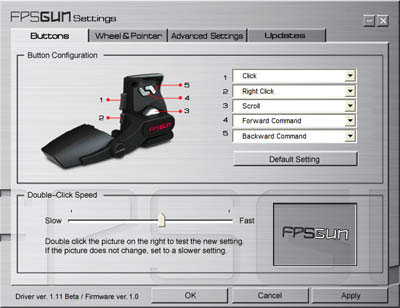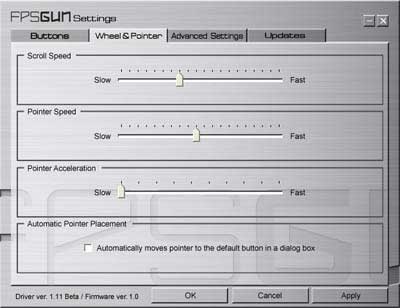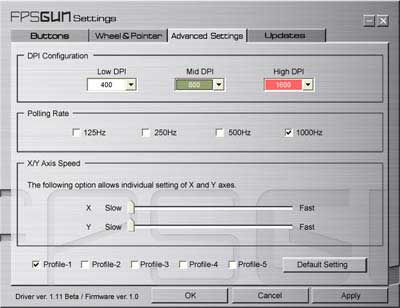 |
||
|
||
| ||
A new way of fraggingZalman is famous enough for its quality PC cooling and liquid cooling devices as well as fans, modding accessories, PC enclosures, gaming headphones, and even 3D monitors. But today we are going to review a "ballon d'essai" of quite a different domain. In fact, target audiences for high quality coolers and modding on the one hand and high quality gaming input devices on the other hand overlap much. But we cannot think of any other manufacturer that would work for the both markets. So, when Zalman introduced a gaming mouse, it was a surprise. And now we have such an unusual device to examine. Vertically oriented mice were invented a long time ago. They have always been designed to replace usual input devices in specific situations. Not in specific tasks, just in situations. E.g. for users suffering from carpal or cubital tunnel syndrome because of usual mice, or those who are afraid of it. Such devices have always been quite expensive, offering limited functionality. But they allowed owners to change the grip. There were few alternatives in the age of ball mice. As sensor technologies progressed, there appeared an opportunity to move a mouse on the side of your thigh. But it was still inconvenient. A year ago Microsoft, also famous enough for its ergonomic series peripherals, presented the "semi-vertical" Natural Wireless Laser Mouse 6000. This one is not very popular because of its radically specific grip, but the concept is certainly an interesting and useful. But some users do not want to change habits, and other do not want to keep several mice on the desk. That is, an ordinary mouse for documents, a precision mouse for games or image editing, and a wireless mouse for controlling PC entertainment from a sofa. There is no universal solution for all situations. And we don't actually need it. Why? Because of the aforementioned carpal tunnel syndrome. Keeping hand in the same position for a long time results in stagnant and then degenerative changes in small joints and ligaments. It may also damage bone base nerves in elbows and little finger side of wrists. These are the preconditions for the tunnel syndrome. Constant microtraumas and static position. Why am I saying all this before actually examining the mouse? Because this input device can be used for more than just its declared purpose. Moreover, this mouse was just as convenient for web surfing and reading documents in my opinion. But let's not put the cart before the horse. Package ContentsA black box with orange labels contains a transparent blister shaped after the mouse, so you can evaluate the device right at the counter. You cannot try it in your palm though, because the mouse is recessed in its package. The package contains the FPSGUN mouse, an installation guide, and a CD with the driver and manual. The bundle also includes a holster for the mouse made of natural (!) cotton velvet.  Design and ErgonomicsThe mouse has an original design like nothing else, but that was clear from the very beginning. The manufacturer compares it with a handgun grip, but it looks more like a small hand plane to me. It's made of high quality materials and assembled well, so nothing squeaks. Most of the plastic is painted black. There is a gray non-slip ribbed panel on the grip. The base of the grip and its edge are dark brown.   The mouse consists of two main parts, a bridge connects the grip with the fore section (the sensor part) on the left. There is a red sensor in the middle of the fore part. Besides, the bottom houses eight small teflon feet. Main controls are situated on the grip. Two buttons for the index and middle finger correspond to the right and left mouse buttons, two buttons on the right - two additional mouse buttons. The wheel with a button under it scrolls in the vertical plane. It does not detect lateral deviation. The main buttons have a medium stroke with a distinct feedback and loud click. Additional buttons are harder to press and quieter. The wheel rotates easily, but it clicks distinctly. We had practically no false presses. It's not convenient to press the button under the wheel, but it works just as well as the others. And finally, the only button on the sensor part allows DPI manipulation. It's a hardware control, you cannot remap it in the driver, but you can choose from 2-3 DPI values for each of the three positions. The current value is indicated by a backlight color of the wheel, read the software manual for details. In fact, we get a usual minimum bundle: four buttons plus a wheel without horizontal scrolling. The 190 cm cord of medium flexibility and thickness does not interfere with mouse movements. It has a gold-plated USB connector.  The following grip method is implied: the little and fourth fingers rest on the stand (a bit too narrow for two fingers, the little finger always slips down to the desk), the middle and index fingers are on the main buttons, and the thumb is on the wheel and additional buttons. So the mouse provides a convenient grip for a medium-sized palm. It was too small for my large palm. And it's too thick for a small hand. Anyway, this grip is OK (not fine), all controls are easily accessible, which eliminates extended gaming session fatigues.  You are supposed to aim with small wrist movements. That is you move the sensor part around the vertical axis that goes through the center of the grip. That's the only correct way according to the manufacturer. However, it's just as easy to move the entire mouse using your arm. On the other hand, it's not very convenient to move the mouse forward or backward. The idea behind this design is as follows - users mostly aim in the horizontal plane, vertical targeting is less intense. Indeed, you rarely need more than 90B° of vertical movement, usually much less. And in the horizontal plane you need at least 180B°, up to several full circles. So limited convenience in one plane for the sake of greater comfort in the other plane is a conceptual idea.  User's wrist lies vertically on the mouse, a tad slanted towards the palm, which is the most healthy position physiologically. In everyday work, high sensitivity of the mouse allows small movements, so you don't lift the mouse very often. You should remember one thing, if you don't want to change your habits because of the new mouse shape. It's so unusual that you don't percept this device as a mouse. That is when you switch back to a usual mouse, your mind just toggles to the mouse mode. But you will have to program yourself to use this "hand plane" from scratch. Two weeks of our tests were not enough to get used to this device. But it mostly concerned working in graphics editors. The new mouse worked fine in games, it felt natural to pull the trigger. But the most convenient mode was browsing documents. Your arm lies relaxed on the desk, unlike some strain with a usual mouse. However, vertical orientation of the wheel is not very convenient here, horizontal wheel would have been better. Besides, there are not very many buttons - a mini joystick on top of the grip would have been welcome, for example. Overall impressions of this mouse are supremely favorable. You can rarely come across such unique solutions, which are quite usable. SoftwareThe drivers are apparently unique, like no other software. The bundled CD includes Version 1.1, but we downloaded Beta 1.11 (2.8 MB) from the web site. I found no differences between them. As the driver displays firmware version, it can be flashed as well.  Button options are not very rich to say the least. Along with the options that you can see on the screenshot, you can just configure a doubleclick or disable a button. Options are identical for all buttons.  This screen actually replicates system settings, it just offers more levels for each of them.  This one is more interesting, like in all gaming mice. There are five profiles, you can switch between them only here. At least I found no other way. You can specify different sensitivity for horizontal and vertical movements, choose one of the four available USB sample rates, and specify DPI for three slots. Low DPI - 400 and 600, Mid DPI - 800, 1000, and 1200, High DPI - 1400, 1600, and 2000. That is DPI can be adjusted from 400 to 2000 at 200 steps, quite a sufficient range. You can switch between these levels by pressing a button atop the sensor part of the mouse. The current DPI level is indicated by the color of the scroll wheel: red for High DPI, blue for Mid DPI, and purple (both LEDs) for Low DPI. Everything corresponds to positioning and class of a given mouse (on this tabbed page). The last tabbed page opens a product web page in your browser. Quite an unexpected turn of events. The drivers work well. When we installed them, they removed our MS Habu. But the system detected our old mouse, when we plugged it back. In fact, it's not mandatory to install the driver, the mouse works well even without it. You can see its default settings on the screenshots above. Our main gripe with the driver is too few actions that can be assigned to the buttons. SpecificationsSpecifications are published on the web site and on the box. It's a good form for gaming mice, because these parameters are on the second place in importance after a mouse shape.
SupportThere is a dedicated product page on manufacturer's website. The www.fpsgun.com also redirects to that page. A serious approach to the brand is inspiring. Perhaps, this product series will evolve in the future. Drivers, usage tips, and high-res photos are also available at that page. We've tested a pre-production sample, so, unfortunately, we don't have information about the warranty.  Operating ExperienceI used this mouse as the main pointing device for one week at work and one week at home. I also played games with this mouse to evaluate its declared purpose. This mouse weighs 160 g. Mouse feet glide well almost on any surface. Friction is quite low on smooth surfaces, cloth and rough surfaces increase friction noticeably. The sensor works well almost on any surface, including an absolutely black mat desktop, which confuses optical mice of the first and second generation. However, it does not work on a CD and a mirror. It does not like green flock on my sofa either. This behavior is typical of most laser sensors of the current generation. The backlight of the sensor may perform only a decorative function. Cursor control is very accurate, I don't have any gripes with it in games. Precision and smoothness of cursor motion is up to the mark. Maximum distance between the sensor and the surface, when the mouse still works, is five millimeters or three stamped CDs (I did this test at public request). It's quite hard to lift the mouse off the surface without moving the cursor, so the manufacturer recommends tilting the grip to the left/right for this purpose. As a result, the FPSGUN works fine in all applications except for graphics editors, if its shape is fine with You. USB sample rate can be configured with system tools, it matches the official values (this fact is proved by all utilities). The sample rate was quite stable, it went down only when the mouse was moving slowly, there were no unexplainable abrupt drops. Attention! High sampling rate puts a heavy load on CPU. That may be the reason why some people are not satisfied with this mouse in resource-intensive applications, especially in games. Since each game distributes available resources in its own way, only its developers know exactly how it's done. USB extension cord (2 m) and KVM do not interfere with mouse operations. When connected through the reference Aten CS-1774 KVM, USB sampling rate was preserved, and the mouse operated at full capacity. AvailabilityAt the moment of publication, this mouse was selling for $60 to $75. ConclusionsOn the whole, this mouse is interesting and quite usable. That is, it's a worthy product for your computer. It can be used for games and other applications. I have a feeling that it's a touchstone. If users like it (which is hard to guess), they can expect more products to come, probably with more functions or for various palm sizes, which is even more important in this specific case. As for this mouse, you should try it in your hand before buying it. Better still, try it at home for a few weeks if you can. Pros
Cons
Peculiarities
Wishlist
Even considering the wishlist, this mouse is a very interesting product indeed. Write a comment below. No registration needed!
|
Platform · Video · Multimedia · Mobile · Other || About us & Privacy policy · Twitter · Facebook Copyright © Byrds Research & Publishing, Ltd., 1997–2011. All rights reserved. |